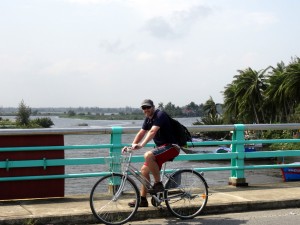The morning after the flooding in Hoi An was beautiful. We rented bikes from our hotel and rode through the palm tree strewn streets to the Cau Dai beach and then north a little ways to the An Bang beach. The beaches were relatively quiet, with a few tourists lounging underneath umbrellas and some locals tempting them with food and drink at small beach front restaurants.
We took a walk up the coast a bit, laughing about romantic walks on the beach for our honeymoon, when Ryan said “This is your honeymoon. Congratulations on marrying me.” Ha ha, priceless! That is definitely a quote I will never forget. Right up there with “Thank you for [pause] other things.” ![]()

Feeling like we’d been a bit lethargic the past few days, we went for a long ride up the coast, on relatively uncomfortable single-speed bikes and under the strong sun. Back in China, we had finished all of our normal 70 SPF sunscreen and had to pick up some 30 SPF sunscreen in a pharmacy. Multiple sunscreen applications and 30 km of biking later, we were both burned to a crisp. And Ryan was a little, uh, uncomfortable from the inadequate bike seating position.

As we all now know, it wouldn’t be a wet season day in Vietnam without some rain. We got the bikes back to the hotel just before the heavens opened. Dinner was at a recommended restaurant in the Old Town, traditional cao lau, a broth with sliced pork, bean sprouts and herbs, for me and a banh mi sandwich, a baguette with seasoned beef, for Ryan.
Our last morning in Hoi An consisted of a walk to the central market, where, not surprisingly, we got caught in a crazy downpour. Even with our umbrellas and rain coats, we were totally soaked. The central market was very interesting though. Reminded us a bit of the market in Cusco, on a smaller scale; lots of veggies, fruits, pig parts, and other stalls with any spices or grains you could possibly want. There was also a big food hall with lots of traditional foods and counters for people to sit down and eat.

On a side note, Hoi An is a UNESCO World Heritage Site, a well-preserved ancient port town with a lot of historical temples and buildings, of which we saw very little.


